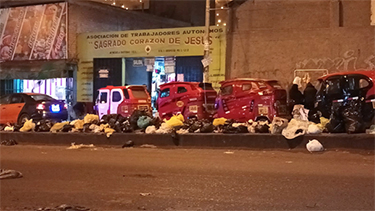The Knight Center for Environmental Journalism recently taught an online environmental journalism to a group of university students in Peru. This is one of the stories produced during that effort. The program was funded by the U.S. Embassy in Lima.
By Valeria Romero Espinoza
The corners of streets and avenues in the district of Villa El Salvador have become a garbage dump that creates an unpleasant landscape for passers-by who pass through these places daily.
The piles of garbage are an ongoing problem because the system for the collection and transportation of domestic and public waste is deficient and disorganized.
There is no proper solid waste management by the local government.
People leave their garbage bags and all types of waste at certain points on public roads, such as sidewalks, parks, avenues and central berms, many of these around markets, hospitals and schools, which leads to the accumulation of large amounts of garbage.

Garbage bags on Av. Micaela Bastidas.
Neighbors say this problem has several roots.
First, there is no established schedule for trucks to pick up garbage in this district. Sometimes the truck does not even show up for several days.
A neighbor resident Reyna says: “Sometimes it doesn’t come for two or three days, a lot of bags get together and it starts to rot, so I tell my sons to take it to the avenue for the truck to pick it up.
“It’s the only option,” Reyna says.
According to the municipality, a single inhabitant of this district produces 167.9 kg of trash per year, which increases the problem of solid waste contamination, since Villa El Salvador population’s is 463,014.
Furthermore, public health is compromised because when the garbage collection system is not working, odors become unpleasant and neighbors choose to incinerate their garbage, which generates potentially harmful gases.
In addition, animals such as pigeons and dogs break and scatter the bags in search of food. Another factor is that informal recyclers open bags and look for materials to recycle and sell by weight.


In the evenings, neighbors leave their wastes in common piles on corners and avenues.
In the evenings, neighbors leave their wastes in common piles on corners and avenues.
The municipal authorities of Villa El Salvador are responsible and do not carry out the management efficiently.
This affects the quality of life of the neighbors like Mrs. Condory, 70 years old, who always goes out with her broom and dustpan to the corner of her street at night.
“People come to leave their garbage at these hours. I always have to put it where the dogs cannot reach it and sweep the trash up if the bags break,” she said.
With municipal elections just around the corner, it is necessary to develop a District Solid Waste Management Plan to improve the collection system and provide environmental education to citizens to segregate and recycle their waste at home.
